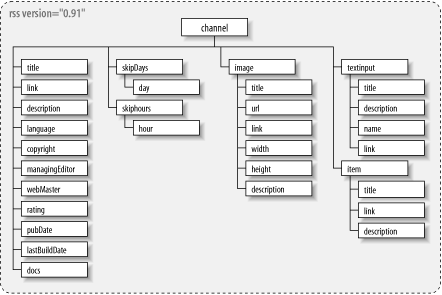Chapter 3. The Main Standards
The nice thing about standards is that there are so many of them to choose from.
—Andrew S. Tanenbaum
In this short chapter, we will summarize the most commonly used XML syndication standards, namely:
RSS 0.91
RSS 0.92
RSS 2.0 and modules
RSS 1.0 and modules
With these four main threads, each expanded on in later chapters, we run the entire gamut of syndication possibilities: from the simple “channel and 15 URLs” of RSS 0.91 to the “unlimited number of entire articles and massive amounts of metadata” combination of RSS 1.0 and modules.
RSS 0.91
The oldest and most established RSS standard still in use, RSS 0.91 was originally released by Netscape’s RSS team, led by Dan Libby, in July 1999. It was later refined and further documented by Netscape, with Userland Software’s Dave Winer. It is based on a combination of Netscape’s RSS 0.90 and Userland’s own older ScriptingNews 2.0b1 format. Neither of those formats are used in any meaningful way today, but RSS 0.91 continues. At the time of this writing, Syndic8 — one of the largest RSS aggregators on the web — has 55% of its feeds declaring themselves as RSS 0.91. While later versions of the 0.9x standard build on this original spec in many useful ways, 0.91 is a good place for the RSS practitioner to start. Figure 3-1 shows a tree representation of RSS 0.91.

Figure 3-1. A tree representation of RSS 0.91
The Specification ...
Get Content Syndication with RSS now with the O’Reilly learning platform.
O’Reilly members experience books, live events, courses curated by job role, and more from O’Reilly and nearly 200 top publishers.

